|
|
|||||||||||
|
|
|||||||||||
 |
|||||||||||
|
|
|||||||||||
|
![]()
| The Secret of Old Three Fists - Brief Overview of the Oldest Methods of Xinyi and Xingyi |
|
by Jarek Szymanski Text - Jarek Szymanski; Photos - Jarek Szymanski and from Japanese "U-shu" magazine (photos of Yu Hualong and Wang Zhonglian); © J.Szymanski 2003 |
| Standard curriculum of Xingyiquan includes Standing Methods (Zhan Zhuang), Five Elements Fists (Wu Xing Quan) and Twelve (Animal) Shapes (Shi Er Xing), empty hand routines (performed by one person or with partner) and routines with weapons. However not many practitioners of Xingyiquan have heard much about Three Fists (San Quan) - Zuan, Guo and Jian, and probably even less have ever seen them. For generations Three Fists were called Three Treasures of Xingyi (Xingyi San Bao), kept secret and passed only to a few chosen students. The names of Three Fists were often written with different characters, very few have seen them, even less learnt them, and as a result many different interpretations of Three Fists appeared. This article is a brief summary of different interpretations of Three Fists that can be found in texts belonging to Dai Family Xinyi, Xingyi, Yi Quan and Xinyi Liuhe Quan traditions. |
| DAI FAMILY XINYIQUAN |
| Three Fists were created by Dai Family clan and are still a part of the
Dai Family Xinyiquan system. It is said that
before Dai clan members learnt Xinyi from Li Zheng and Praying Mantis Boxing from
Jin Shikui, they had already been known for Three Fists (and Three Sticks
- San Quan San Gun). Only later Five Elements Fists were created,
based on Three Fists, Three Sticks and Four Seizes routine (Si Ba Chui;
possible origins of Five Elements Fists will be described in one of later
articles). Dai Family Xinyi Boxing Manual (Dai Shi Xinyi Quan Pu) includes very detailed description of how Three Fists should be performed and linked with other techniques: "Three Fists and Three Sticks are exceptional, tight position, round and full is the right path (in practice); when the student reaches exceptional level (of skill), he will become number one in martial arts. |
|
Dashing Forward/Drilling Fist (Zuan Quan) is like lightning, Wrapping Fist (Guo Quan) resembles leap of a tiger, Scissors Fist (Jian Quan) is like a horse galloping, (they should be) practiced linked as one movement". A more detailed description of Three Fists follows the above classical text: "The hand in Drilling Fist performs Waving Across (Hui Ge), but must not (do it) high, the shoulder turns over (Dian). The hand in Wrapping Fist performs Supporting Across (Tuo Ge), but must not (do it) in explosive (manner), the elbow should Push Against (Ding), must not (do it) high, (but) should follow straight line. Scissors Fist uses both elbows to Push Against (Ding) when Rising (Qi), and Pressing Down Shoulder strike (Ya Mo Bang) when Falling (Luo). The lower hand in Wrapping Fist belongs to Earth (i.e. lower) Basin (Di Pan), the lower hand in Scissors Fist also belongs to Earth Basin (Di Pan), however (the movement) downwards in Scissors Fist is like Pouncing (Pu) - resembles lower hand in Tai Bird Shape (Tai Xing); when Rising (Qi) both elbows are kept together and pounce forward vigorously and one rises and breaths out, (it is) like opening scissors, both elbows are kept tightly to the heart, and the front parts of both forearms as well as tips of elbows are used only. This posture comes after Drilling, (it) rises (Qi) after Drilling, like Swallow Drinking Water (Yanzi Qu Shui). One (may) add Lower Strike (Di Chui) linked with Ground Digging Cannon (Jue Di Pao) when practicing Drilling Fist. One (may) add Pressing Down Shoulder strike (Ya Mo Bang) to Scissors Fist. One (may) add Mantis Hand (Tanglang Shou) to Wrapping Fist, Lower Strike (Di Chui) should also be added; also Wind Wrapping Shoulder (Guo Feng Bang) strike can easily change into Mantis Hand (Tanglang Shou). Generally speaking, (additional) postures in the fist method are not linked in practice, however when used all should be linked, it all depends on the practitioner's ability to adapt to circumstances. Besides in Drilling Fist the step should be small, (because) only when the step is small it is easy to turn over the shoulder; in Wrapping Fist the elbow should be kept low, (because only when) the elbow is kept low the danger (of receiving a strike) can be avoided. Besides in Wrapping Fist Wrapping (Guo) is Protecting (Gu), (while) the elbow movement is Striking (Da). In elbow movement the hand is like Mantis Hand (Tanglang Shou) entering the Outside Gate (Wai Men), and the body should be very nimble. Hence it is important to use Dragon Body (Long Shen). This boxing method has three methods of practice - Front Gate (Zheng Men), Outside Gate (Wai Men) and Earth Basin (Di Pan)." [from: "Dai Family Xinyi Boxing Manual", hand written manuscript] As the above texts indicate, Three Fists are three techniques - Drilling Fist (Zuan Quan), Wrapping Fist (Guo Quan) and Scissors Fist (Jian Quan) performed in a linked manner as one continuous sequence. However they can change at any moment into another technique, depending on the reaction/movement of the opponent; besides some additional techniques can be added to the basic Three Fists to make them more effective. Shoulder and elbow strikes are important components of Three Fists. While footwork and movement of the body (Shen Fa) are the core of Dai Family Xinyiquan, it is the movement of arms (shoulders, elbows, hands) that makes Three Fists what they are. |
| Three Fists of Dai Family
Xinyiquan Demonstrated by Huo Yongli, disciple of Duan Xifu and grandstudent of Dai Kui |
|||||
| Zuan (Drilling) | Guo (Wrapping) | Jian (Scissors) | |||
| Drilling Fist (Zuan Quan) | Wind Wrapping Shoulder (Guo Feng Bang) | Horse Shape (Ma Xing) | |||
q |
q |
q | |||
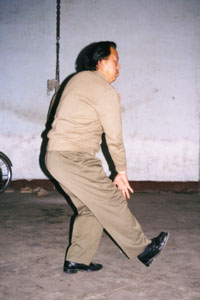 |
|||||
| Shoulder drops down... | |||||
| ¤ | |||||
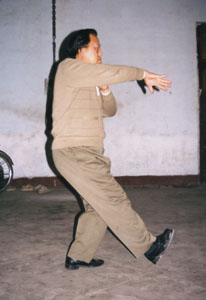 |
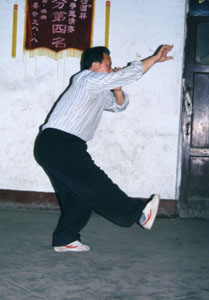 |
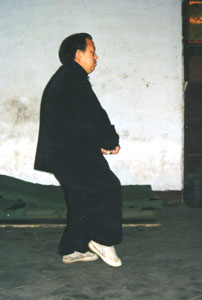 |
|||
| Shoulder "turns over" - draws a circle - upwards, backwards... | |||||
| ¤ | |||||
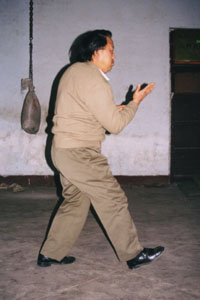 |
¢ | 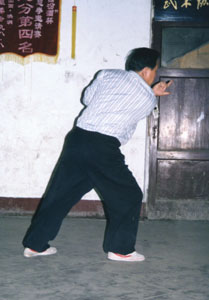 |
¢ | 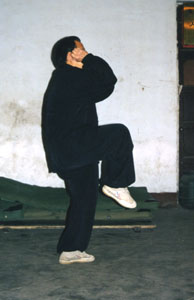 |
|
| ...downwards and forwards, hand drills obliquely forward | Wrapping Fist (Guo Quan) the body twists leftwards so that right shoulder points forward |
Scissors Fist (Jian Quan) both arms first cross in front of the body and then move upwards and outwards "like opening scissors" |
|||
| kkk | |||||
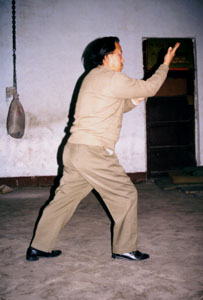 |
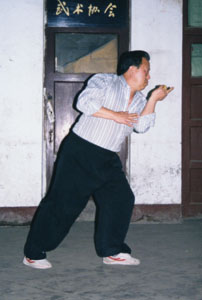 |
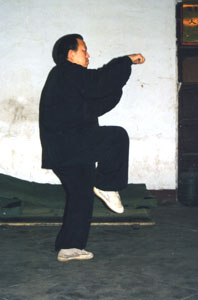 |
|||
| Reverse View of Wrapping Fist (Guo Quan) | |||||
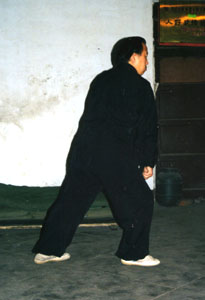 |
|||||
| Pressing Down Shoulder strike (Ya Mo Bang) can follow Scissors Fist | |||||
| kkk | |||||
|
|||||
| XINGYIQUAN |
|
Old Boxing Manuals belonging to Xingyi tradition clearly mention Three Fists (San Quan) as three techniques which are linked and performed together as one movement: "Three Fists (San Quan) - these are Drilling Fist (Zuan Quan), Wrapping Fist (Guo Quan), Stepping Forward Fist (Jian Quan). Drilling Fist is like lightning. Wrapping Fist resembles leap of a tiger. Stepping Forward Fist is like a horse galloping, (they should be) practiced linked as one movement". The above description comes from an old Xingyiquan Manual (Xingyi Quan Pu). Here another character for "Jian" in Jian Quan - meaning "Stepping Forward" was used. While some Xingyi manuals miss the details of Three Fists, some provide description very different from what Dai Family Xinyi manuals say: "The Image of Three Fists (San Quan Xiang) - Drilling Fist (Zuan Quan), Wrapping Fist (Guo Quan), Stepping Forward Fist (Jian Quan); Drilling Fist is like lightning, Wrapping Fist resembles dwelling forward, Stepping Forward Fist is like a horse galloping, (they should be) practiced linked as one movement. The starting movements are three advancing and retreating Crushing Fists (Jin Tui Beng Quan), complete Crow Shape (Gua Xing) changes into Cannon Fist (Pao Quan), Snake Shape (She Xing) on one side, Drilling (and) Horizontal Fists (Zuan Heng Quan), Raising and Falling of Dragon Shape (Long Xing Qi Luo), Turning with Fist of Canon (Quan Pao), performed linked at one go.[from: Liu Peiyi, Liu Peijun: "Collection of Traditional Martial Arts Practiced by Liu Family"] |
| Below: Drilling Fist (Zuan Quan) of Song Style Xingyiquan (demonstrated by Song Guanghua) |
However in modern articles Xingyiquan practitioners give a different interpretation of Three Fists: "Three Fists and Three Stick endlessly give birth to Heaven, Earth and Man" - this sentence points out the features of powers in Xingyiquan and their changes. All movements sideward are called Scissors (Jian), pushing opponent's hand horizontally inwards is called Wrapping (Guo), the power issued obliquely forward and upward is called Drilling (Zuan). For example in Drilling Fist (Zuan Quan) all three - Scissors, Wrapping and Drilling - are used. These are not only the powers obliquely forward and to the sides, but it also expresses the power directed upwards, downwards, forwards, backwards, leftwards and rightwards - "six-sides Power" (Liu Mian Jin), just like Peng Jin in Taijiquan and Contradictory Strength (Zheng Li) in Dachengquan. Three Fists are the feature of Xingyiquan, effective measure to protect one's central line." [from: "About Practice of Xingyiquan" by Xu Fanzeng, Song style Xingyiquan expert] Closer analysis of Three Fists of Dai Family Xinyi shows that the techniques cover six basic directions: Drilling Fist - downwards, upwards, forwards and backwards, Wrapping Fist - from outside inwards, Scissors Fist - from the inside outwards. Probably this feature gave way to the above interpretation of Three Fists popular within Xingyi circles. |
|
|
| Other practitioners of Xingyiquan consider Three Fists to be the oldest techniques of the system and included in Five (Elements) Fists. According to this interpretation the Three Fists were: Pi (Chopping), Zuan (Drilling) and Beng (Crushing); Pao (Canon Fist) and Heng (Horizontal Fist) were added later. |
| YI QUAN | |
|
Wang Xiangzhai, the founder of Yi Quan (Intent/Mind Boxing, also known as Dachengquan - Great Achievement Boxing) also mentions Three Fists in many of his writings, including the early "The Right Path of Yi Quan" (Yi Quan Zheng Gui) as well as "Central Pivot of the Path of Boxing" (Quan Dao Zhong Shu) written later: "The right path of Intent Boxing (Yi Quan) does not go beyond the ancient postures of old Three Fists and two energies (Qi) of Dragon and Tiger. Two energies of Dragon and Tiger are skills, Three Fists are (used for) fighting. Three Fists are Stepping Forward (Jian), Drilling (Zuan), Wrapping (Guo). Stepping Forward Fist (Jian Quan) is hard on the outside and soft inside and has Static Strength (Jing Li, also called Straight Strength, Ting Li), (and is) called "Empty Inside" (Xu Zhong), in application it is hidden, awaiting to be released. Drilling Fist (Zuan Quan) is soft on the outside and hard inside like steel wrapped in cotton, it has Elastic Strength (Tan Li), (and is) called "Firm Inside" (Shi Zhong), it is used to counter-attack when one is in passive position. Wrapping Fist (Guo Quan) combines hardness and softness, it has Shocking Strength (Jing Li), (and is) called "Changing Inside" (Hua Zhong), and used on one's own initiative, no matter how different the opponents are, (I) shock (him) and immediately defeat (him) (...)" [from: "The Right Path of Yi Quan" published in 1928] In 1963 Yao Zongxun added some notes to the above text: "(New contents) was later added to the explanation of Three Fists - 'Stepping Forward Fist' refers to footwork, 'Drilling Fist' means hand and forearm, 'Wrapping Fist' refers to body method (Shen Fa), and it has the meaning of containing all manifestations." [from: Additional Notes to "The Right Path of Yi Quan" 1963] The above interpretation is very general as it contains all three basic components of each technique - footwork, the way the body is used as well as specific movement of the hands. However in his later writings Wang gave slightly different description of Three Fists: "At its beginnings Xingyiquan had Three Fists, and these Three Fists - so called Stepping Forward (Jian), Drilling (Zuan), Wrapping (Guo) - were one movement. (They) resembled a horse galloping (Ma Ben), linked, performed at one go as a combination of three strengths (to achieve) one result; as far as Five Elements (Fist) and Twelve (Animal) Shapes are concerned, they were also included (in Three Fists)." [from: "Central Pivot of the Path of Boxing", 1944] |
|
| XINYI LIUHE QUAN |
| Ma Shengli, Xinyi Liuhe Quan
practitioner from Shanghai, has recently published an article in which he
gave his own explanation of Guo (Wrapping), Jian (Stepping
Forward) and Zuan (Drilling). He rejects the idea of Zuan -
Guo - Jian as three fist techniques. Instead he explains that
they are directly related to the way the body is used (so-called Body
Method - Shen Fa) and footwork of Xinyi Liuhe Quan: "So-called "Wrapping" (Guo), is also called "Contracting" (Shu) or "Storing" (Cun); it is the method the force is stored (Xu Li) in every movement before it is released (Fa Li) (method, not specific movement!). We know that in any kind of martial art, if it has releasing of force, then it certainly has a process of storing of force, even if this process is very short. The method of storing of force is actually the way how to use the gravity and reacting force of the ground. Because these two forces are the necessary condition under which we human beings can release force. This principle was fully understood by old masters of Xinyi Liuhe Quan and they very clearly used it in teaching. Its detailed practice is as follows: prior to releasing power in certain movement, first shift the center of gravity mainly onto one leg (which becomes "firm"), then suddenly relax this leg, the body (buttocks) drop down, then immediately tense and press down with the foot, so that the reactive force of the ground is clearly transmitted to the back of the waist (so-called "Supporting Posture"); in this way the process of storing of force has been completed. Of course "Wrapping" cannot be separated from "Stepping Forward" and "Drilling"; here - because of language limitations - they have been described separately, but when actually performed there must not be any pause between them. So-called "Stepping Forward" (Jian) is taking a long step forward, but it also contains an idea of forcing one's way through. This is the method of "Advancing" (Jin Bu). So-called "Drilling" (Zuan) is the movement forward and upward accompanied by release of power. It requires that the head "leads" the force upwards, the neck straightens up, the back pulls up, "Middle Joint" (Zhong Jie, i.e. waist and hips) shifts forward, and in consequence the body "Drills" forwards and upwards; power is also released in the same direction. This is called the method of "Advancing with the Body" (Jin Shen). Releasing power while "Advancing with the Body" and releasing power while "Closing with the Body" (Jin Shen, both methods have identical pronunciation, but first characters are different) are not the same, and usually people confuse one with the other. So-called "Advancing with the Body" is the method of the body "Drilling" upwards, while "Close with the Body" simply means closing in on the opponent. It can be said that if one does not understand the method of "Advancing with the Body", he will not achieve the ability to strike the opponent like "pulling up weeds" (Ba Cao), and will not understand the meaning of "Striking the Opponent is like Kissing (him)" (Da Ren Ru Qin Zui). In practice "Wrapping", "Stepping Forward", "Drilling" cannot be separated; the whole process can be described as follows: first relax the waist and leg ("firm", supporting leg) to drop down the body ¢ press down with the foot so that the reactive force of the ground is transmitted to the waist ¢ simultaneously the "empty" leg (i.e. leg which does not support the body) takes a step forward ¢ the center of gravity shifts forward, head leads upwards, "Middle Joint" pulls up, the body moves forward and upward and hastens the release of power. As we know in Xinyi Liuhe Quan one practices "the Powers of Three Passes and Nine Joints" (San Guan Jiu Jie Jin); once the movements of the body in "Wrapping", "Stepping Forward", "Drilling" have been performed correctly, then "the Powers of Three Passes and Nine Joints" have been linked up, and so-called the "Complete Body Power" (Zheng Jin) has been developed." In Ma Shengli's opinion Guo - Jian - Zuan form basic pattern of collecting and issuing power in Xinyi Liuhe Quan. The order of these three movements/methods differs from that in other writings - Ma lists them as Guo - Jian - Zuan while in case of Dai Family Xinyi, Xingyiquan and Yi Quan the order is Zuan - Guo - Jian. It is important to point out that Ma Shengli's explanation corresponds with Contracting (Shu) and Opening (Zhan) with Tiger Step (Hu Bu, bow step) of Dai Family Xinyi - the basic pattern of releasing power in Dai Family Xinyiquan system. Ma also sees Guo - Jian - Zuan as basic method to release power in Xinyi Liuhe Quan. The main differences are more compact postures and more obvious way of storing in the body (contracting) in Dai Family Xinyiquan which is not so pronounced in Henan Xinyi Liuhe Quan. |
| Comparison of Guo - Jian - Zuan of Henan Xinyi Liuhe Quan and Shu - Zhan of Dai Family Xinyiquan | |||
Horizontal Fist (Heng Quan) of Henan Xinyi Liuhe Quan is demonstrated by Yu Hualong, student of Lu Song'gao); Horizontal Fist (Heng Quan) of Dai Family Xinyiquan is demonstrated by Wang Zhonglian, son of Wang Yinghai and grandstudent of Dai Kui |
|||
|
|
|||
| Henan Xinyi Liuhe Quan | |||
| kkk | |||
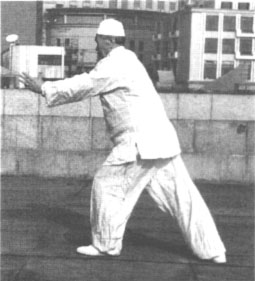 |
¡ | 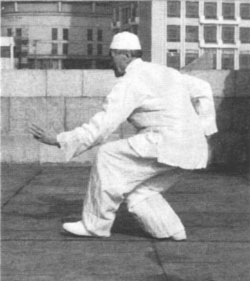 |
|
| Jian (Stepping Forward - with front leg) Zuan (Drilling - moving body forward and upward), releasing power (and striking with right fist) | Guo (Wrapping) Body relaxed, "sits" on rear (supporting) leg, storing power |
||
|
|
|||
| Dai Family Xinyiquan | |||
| kkk | |||
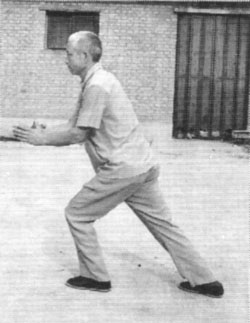 |
¡ | 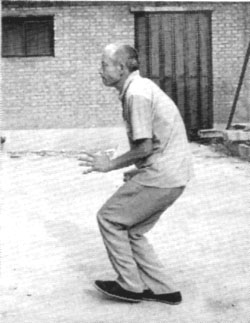 |
|
| Zhan
(Opening) Front leg steps forward, rear leg straightens and body "opens", power is released (strike with right fist) |
Shu
(Contracting) Weight on rear leg, legs bent, body contracted, power is stored |
||
Horizontal Fist (Heng Quan) is one of four core ("mother") techniques of both systems, which along with Eagle Grasp (Ying Zhuo), Raising and Leading (Tiao Ling) and Cutting Hand (Zhan Shou) is a part of Four Seizes (Si Ba) routine. |
|||
| On the other hand late Pei Xirong
(student of Lu Song'gao and Bao Ding) in his "Henan Style Xingyiquan (Ten
Animal Shapes)" (handwritten copy, later edited and published under the
same title) gives very different description of Three Fists: "Three Poisons (San Du): these are Three Fists and Three Sticks. Three Fists are: Single Seize (Dan Ba), Head Crushing Stone Tablet (Yi Tou Sui Bei), Horizontally Opening Three Imperial Locks (Heng Kai San Huang Suo) (...)". It is another take on Three Fists - according to Pei these are (unlike for Ma Shengli's) three specific techniques, but different from "standard" Zuan - Guo - Jian. |
| SUPPLEMENTARY NOTES: |
"Jian (Leaping Forward/Stepping Forward) (refers to) legs, Zuan (Dashing Forward or Drilling) (refers to) the body (...)" Jian is also mentioned in the fifth part of "The Extracts of Ten Methods" (Shi Fa Zhai Yao, attributed to Cao Jiwu) as one of the more difficult footwork methods, used against a tall and strong opponent. It is interesting to note that - according to the text - this footwork "is like a horse galloping, leap of a tiger", the exact phrase which can be found in the description of Three Fists in Dai Family Xinyi Boxing Manual. Guo (Wrapping) is the third method in the chapter "The Contents of Intent Boxing" (Yi Quan Mulu), however it is not followed by any explanation. The first eight characters in the chapter constitute famous "Eight Characters Method" (Ba Zi Gong), which belongs to Xingyiquan curriculum. Guo is usually linked with Kua (Hips), and Guo - Kua is explained as contracting the whole body. It is also mentioned as one of five methods - along with Cai (Stepping on), Pu (Pouncing), Shun (Smooth) and Jue (Bursting) - in the chapter "Method of Bursting" (Jue Fa): "Guo (Wrapping) (means) wrapping up (so that) nothing is shown (...)" These five methods are explained as: "Feet step on (Cai), hands pounce (Pu), body wraps (Guo), Qi is smooth (Shun), the power is issued in a shaking and explosive (Jue, like bursting a dyke) (manner)." While the above meanings of Zuan, Guo and Jian are in conformity with Ma Shengli's description, it is not difficult to notice that they differ from Three Fists of Dai Family Xinyi (and their idea expressed by Xingyi and Yi Quan practitioners). This could be due to the fact that Three Fists (understood as three linked techniques) are based in Dai family system, from which Xingyiquan developed (which in turn was main base for Yi Quan), while they are not known in Henan Xinyi Liuhe Quan. While there are some similarities between these two interpretations, they should not be mixed together and confused. |
To learn more about Dai Family Xinyiquan and Henan Xingyiquan please check the following articles:
These as well as many other articles on Xingyiquan can be found here. |
End of "The Secret of Old Three Fists - Brief Overview of the Oldest Methods of Xinyi and Xingyi"; © J.Szymanski 2003 |
Home ▪ About me ▪ Updates ▪ Taiji ▪ Bagua ▪ Xinyi-Xingyi ▪ Other Styles ▪ News ▪ Store ▪ Community ▪ Email